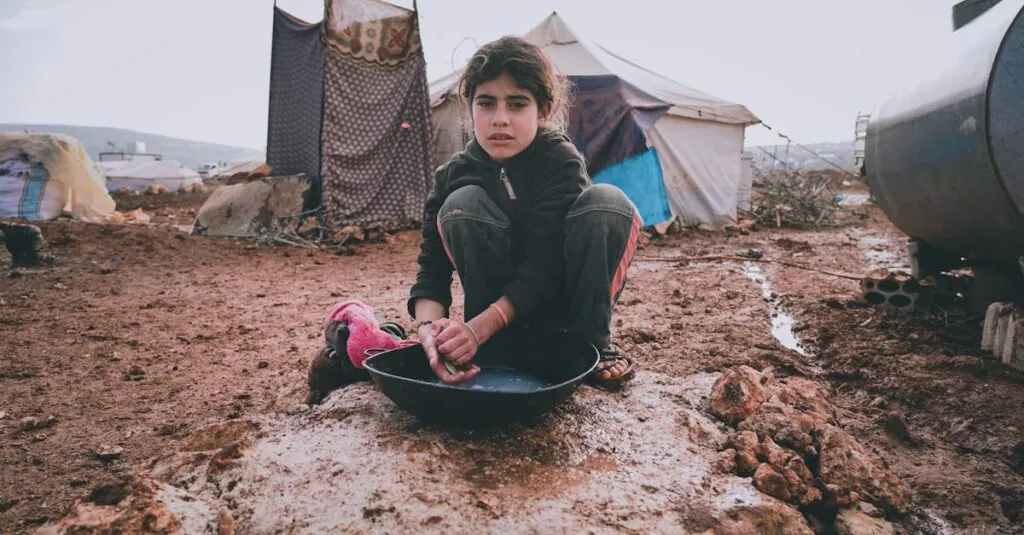Poverty isn’t just a statistic; it’s a global challenge that affects millions. The International Poverty Index (IPI) aims to shine a spotlight on this pressing issue, measuring poverty in ways that go beyond mere income. It’s like a magnifying glass for the world’s financial woes, revealing the hidden struggles people face every day.
Imagine trying to navigate a maze blindfolded—that’s what life can feel like for those living in poverty. The IPI helps policymakers and organizations cut through the fog, providing insights that lead to effective solutions. By understanding the multifaceted nature of poverty, we can tackle it head-on, armed with the knowledge to make a real difference. So, let’s dive into the numbers and discover how the IPI is reshaping the fight against poverty, one statistic at a time.
Table of Contents
ToggleOverview of International Poverty Index
The International Poverty Index (IPI) provides a comprehensive assessment of poverty that extends beyond mere income measurements. It incorporates various dimensions such as health, education, and living standards to create a more nuanced understanding of poverty levels. Policymakers utilize the IPI to address the complexities surrounding poverty and to tailor their approaches to diverse situations.
Established methodologies behind the IPI allow for systematic data collection across different regions. Countries or regions with higher IPI scores indicate greater poverty challenges, signaling the need for targeted interventions. Evaluation of the IPI reveals stark contrasts in poverty experiences globally, highlighting disparities among urban and rural populations.
Data from the IPI enables organizations to monitor progress over time. Tracking changes in poverty levels can inform strategies and policies, ultimately driving improvements in quality of life. Investors in social programs rely on the detailed insights provided by the IPI to allocate resources effectively.
Various organizations contribute to the calculation of the IPI, ensuring a collaborative effort. Institutions like the World Bank play a vital role in validating and disseminating IPI data. Ongoing research enhances the understanding of poverty’s multifaceted nature, further enriching the framework for tackling this global issue.
Overall, the IPI stands as an essential tool for understanding and combating poverty on a global scale. Utilizing its data helps all stakeholders develop effective solutions, aiming for sustainable change and improved livelihoods.
Historical Context
Poverty indices emerged as essential tools for understanding and addressing global poverty. The earliest efforts to quantify poverty started in the 20th century, guided by economic theories and social studies. Research highlighted that income alone does not capture the full scope of poverty. This led to the development of multidimensional measures, with the International Poverty Index gaining prominence in the 21st century. This index integrates health, education, and living standards to provide a comprehensive view of poverty.
Global initiatives aimed at poverty reduction have gained momentum, especially since the mid-1990s. The World Bank and United Nations spearheaded collaborative efforts, prioritizing sustainable development goals. Progress in poverty alleviation stems from numerous programs targeting marginalized populations. Countries worldwide implemented various strategies tailored to their unique circumstances, reflecting diverse poverty experiences. Reports indicate that substantial investments in education and healthcare significantly reduced poverty rates, showcasing the effectiveness of targeted interventions. Overall, these global efforts emphasize collective responsibility in the fight against poverty.
Methodology of the International Poverty Index
The International Poverty Index employs a multifaceted approach to assess poverty beyond mere income levels. It evaluates diverse factors that contribute to overall wellbeing.
Indicators Used
Indicators for the IPI encompass several dimensions of poverty. Health metrics may include child mortality and nutrition status. Education factors often involve years of schooling and literacy rates. Living standards indicators assess access to clean water, electricity, and housing conditions. These indicators collectively provide a comprehensive picture of poverty, revealing how it impacts various populations across regions.
Data Collection Processes
Data collection for the IPI occurs through systematic methods. Surveys and census data provide primary information, ensuring accuracy in measurement. Collaborating organizations like the World Bank work with local agencies to gather relevant data from households and communities. This partnership enhances the reliability of the information obtained. Ongoing monitoring and updates allow for tracking changes in poverty levels over time, furnishing essential insights for policymakers.
Implications of the International Poverty Index
The International Poverty Index (IPI) carries significant implications for understanding and addressing poverty on a global scale. Its multifaceted nature aids in recognizing the complexities behind poverty, shaping effective strategies.
Policy Formulation
Policy formulation relies heavily on insights provided by the IPI. Accurate data on health, education, and living standards informs decisions made by governments and organizations. Planners utilize the IPI to identify specific areas in need of intervention, ensuring targeted support reaches the most vulnerable populations. Resources allocated effectively lead to improved living conditions and enhanced quality of life. Custom strategies develop based on the unique experiences of communities, reflecting their specific challenges. Policymakers track progress using IPI data, adjusting initiatives to address emerging issues.
Economic Development
Economic development finds substantial support through the IPI framework. Understanding poverty requires recognizing factors beyond income, which the IPI captures. Targeted efforts aimed at education and healthcare result in sustainable economic growth. Communities experience enhanced workforce participation as poverty alleviates, which stimulates local economies. Investment in infrastructure, facilitated by IPI insights, ensures improved living conditions lead to broader economic advantages. By focusing on comprehensive poverty alleviation, countries create more resilient economies. Enhanced collaboration among nations fosters shared solutions and drives collective progress.
Critiques and Challenges
Critiques of the International Poverty Index (IPI) highlight various challenges associated with its application. While the IPI provides a multidimensional framework, certain limitations affect its effectiveness and comprehensiveness.
Limitations of the Index
The IPI may not adequately reflect local poverty conditions. Cultural factors influence how poverty is experienced but often remain unaccounted for in the index. Variability in data collection methods can lead to inaccuracies, especially in regions lacking robust statistical systems. Furthermore, the complexities involved in measuring non-monetary aspects of poverty can result in oversights. High dependency on three key dimensions may also neglect other critical factors, such as employment and access to social services.
Alternate Measures of Poverty
Several alternate measures exist alongside the IPI to address its limitations. The Human Development Index (HDI) incorporates income, education, and life expectancy, offering a different perspective on well-being. Wealth metrics facilitate insight into economic disparities, while the Multidimensional Poverty Index (MPI) provides a distinct approach, emphasizing deprivations across ten indicators. Each measure varies in focus and methodology, allowing for a more nuanced understanding of poverty’s complexities. Policymakers often leverage these measures to create comprehensive strategies, addressing multiple poverty facets and fostering targeted assistance for vulnerable populations.
The International Poverty Index stands as a vital instrument in the fight against global poverty. By offering a nuanced view of poverty that transcends mere income, it highlights the interconnectedness of health, education, and living standards. This comprehensive approach enables policymakers to devise targeted interventions that address the specific needs of diverse populations.
Despite its limitations, the IPI remains instrumental in guiding efforts toward sustainable development. As organizations continue to collaborate and refine their methodologies, the insights gained from the IPI can drive meaningful change. Ultimately, understanding and addressing the complexities of poverty through the IPI fosters hope for a future where improved livelihoods are within reach for all.




